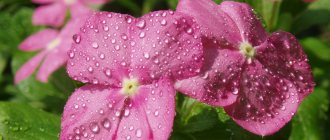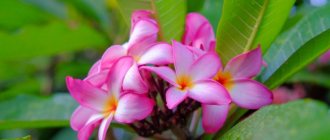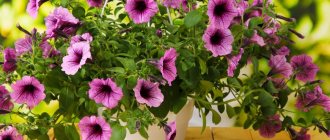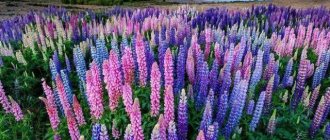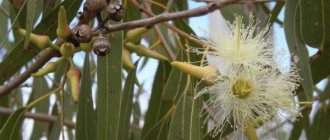Proper pruning. We form a lush balsam bush.
The leading engineer of the gardening department of the Krasnoyarsk flora and fauna park “Roev Ruchey” shared with us her secrets on how to get lush, beautiful balsam bushes.
In the summer, a large number of balsams bloom in the park. In the conditions of Eastern Siberia, this plant is successfully grown as an annual and does not overwinter in open ground. In order not to sow a large number of plants every year, the gardening department leaves the strongest balsam bushes every autumn and uses them as queen cells, that is, donors of cuttings for future plants.
In order to get a powerful, strong bush that will look great and bloom profusely, you need to spare no balsam when pruning. All the resulting shoots will not be lost; they can be rooted.
Before you start, make sure that the plant is not sick and receives enough fertilizer. Before pruning, you may need to increase the amount of fertilizer you apply or fertilize more often.
Here, for example, is what the schedule for fertilizing with organic fertilizer looks like for February-March in the gardening department. During these months, cuttings are actively taken so that the young plants are ready for the season.
Trim the long shoot an inch above the lowest node.
From this node, several new shoots will subsequently develop.
To avoid rotting and other unpleasant consequences, the cut must be clean, even and at an angle of 45 degrees.
A utility knife is best for cutting.
This is the kind of “stump” you should get in the end.
Without regret, we do this with all single (non-branching) long shoots.
After finishing the pruning, we ended up with a “trimmed” plant that will actively grow and form a lush, regular bush.
Trimmed shoots will not be lost. We take cuttings and root them to produce new balsams.
We will talk about the correct cuttings of balsam and petunias in the following articles, so give a thumbs up and subscribe to this channel so you don’t miss anything.
Also, run into the contact group of the gardening department, who shared their secrets with us:
Source
Photos of examples of using a perennial flower
A small selection of photos shows various ways to decorate areas. The use of balsam in landscape design is enormous. Huge compositions are made from flowers, planted in flower beds in groups and individually, and used in garden plots. Various shades will highlight the beauty of garden paths and building facades.
Contrasting duet of balsam with coleus
Tall balsams in the same flower bed with hostas
A spectacular combination of balsam and begonia
Rules for caring for garden balsam seedlings
To grow good and healthy balsam seedlings at home, you need to properly care for them and maintain optimal conditions. Let's look at all the rules and features in more detail.
Care scheme after sowing and before emergence:
- Seeds germinate in light, so you need to immediately place the container in a bright place.
- The temperature is maintained around 22-25 degrees Celsius.
- The greenhouse needs to be ventilated every day for 15 minutes - morning and evening. Condensation must be removed from the lid or film.
- Seeds should always be kept in moist soil, otherwise, when they dry out, the swollen seeds will lose their viability and will not germinate. Therefore, watering must be done regularly, preventing the soil surface from drying out. But there is no need to overfill either. Moisturize using a spray bottle so that the water can be distributed as evenly as possible.
- When the first shoots appear, you need to open the greenhouse gradually - first for an hour, then increase the time every day - on the second day by 3-4 hours, on the third - by 5-6 hours, on the fourth day the lid or film is completely removed.
Rules for caring for balsam seedlings at home after germination:
Now watering needs to be done at the root so that water does not fall on the seedlings, it is advisable to do this along the edge of the container. It is very convenient to water plants using a regular syringe or a small syringe. It should be moistened as the top layer dries, but underneath the top layer the soil should always be slightly moist.
- Immediately after the first loops appear, the temperature of the balsam seedlings decreases; now it is necessary to maintain +18°C during the day and +16°C at night.
- At this stage of growing, seedlings need good lighting even more. The length of daylight required for normal growth and development is at least 12-14 hours, for this reason it is necessary to supplement the plants with phytolamps or at least LED lamps.
What to do if balsam seedlings have stretched out
Seedlings can stretch out for three reasons: sowing too early, elevated temperatures, and lack of lighting. Pulling can be very easily prevented if you plant on time, provide additional light to the plants and provide optimal temperature conditions.
But what to do if the balsam seedlings have already stretched out?
- If you just started to stretch out, then you need to change the conditions - put it in a cooler place and be sure to use phytolamps in the morning, evening and in cloudy weather.
- If it has stretched out too much, then it is better to transplant it into separate pots before the stem falls under the weight of the leaves. Read below about how to transplant.
Planting and care in open ground
"Tom Thumb" is planted in the garden plot in May, when the threat of frost has passed. The plant is afraid of the cold, so in regions with changeable weather, strong winds and prolonged rains it does not feel well. Also, the flower does not tolerate drought; in the open sun it needs abundant watering.
At an air temperature of +20-25 0C (late May-early June), “Tom Thumb” can be sown in open ground. But when it gets cold, young crops should be covered with acrylic, spunbond or film.
Site selection and soil preparation
"Tom Thumb" likes light, fertile, non-acidic and well-drained soil, moderate sun and the absence of wind and drafts. An ideal place for planting would be a bed near a hedge or near bushes.
Before the planting procedure, it is advisable to treat the soil with fungicides, lightly fertilize it with rotted manure or vermicompost and water it.
Attention! If there is an excess of nutrients, “Tom Thumb” begins to get sick and shed its leaves.
Transplanting seedlings
When planting seedlings of balsam "Tom Thumb" in flower beds, the seedlings are removed along with a clod of earth, placed in holes, sprinkled with soil and slightly pressed. It is advisable to mulch the soil around the bushes with sawdust, then it will not dry out and the roots will not be washed away when watering. Impatiens grow luxuriantly, so an interval of 30 cm is maintained between sprouts.
Young shoots must be transplanted carefully so as not to damage them.
Rules of care
For good growth and development, the Tom Thumb balsam needs to be properly cared for. The plant is moisture-loving, but excessive watering can cause its death. You need to moisten the flower often, but in moderation. In rainy weather, it is better to refuse irrigation. For long flowering it is worth feeding the crop. The procedure is performed at the initial stage of development before the buds appear. Minerals combined with nitrogen are better suited for this purpose. After flowering begins, instead of nitrogenous fertilizing, complex fertilizers for flowering plants are applied. They are added during watering every two weeks. Feeding with phosphorus and potassium will be useful. At the end of August, they stop adding nutrients.
Advice! “Tom Thumb” is watered using the sprinkling method so that the water gets on the flowers and leaves.
Wintering
If you try hard and provide the Tom Thumb balsam with suitable conditions, it can bloom even in winter. To do this, install phytolamps and constantly maintain a temperature of +25-29 degrees. The plant will also need fertilizing, which is applied once a month. But even if these recommendations are followed, “Tom Thumb” may begin to fade, then it is better to use such a bush for cuttings.
Balsam tom tumb
Impatiens (impatiens) is an annual herbaceous plant reaching a stem height of 20-75 cm. The popular name is impatiens impatiens, named because of its sensitivity to touch. The homeland is China, India, Central Asia, but the flower is perfectly adapted to growing in temperate latitudes.
For a plant such as garden balsam, planting and care is a very undemanding task. Without much effort, it can be grown in a flower bed, balcony, windowsill, small and large pots. Flowering lasts from the end of May until the start of frost.
Often bicolor, the flowers are simple and double, in inflorescences and single (purple, red, white).
Varieties of garden balsam
In total there are approximately 500 types of balsam. Garden varieties of different colors were developed:
- Impatiens tom samb violet is an annual plant no lower than 20 cm. It grows quite quickly and blooms densely with purple double flowers. Loves warmth, but easily tolerates slight shading. Flowering occurs from early summer to early autumn;
- Impatiens tom samb bicolor is an annual bush, reaching a height of 20 cm or more. The flowers are beautiful, double, and have a white and red color. Planting seeds begins in March-April. Blooms all summer until September. Suitable for growing indoors and outdoors;
- Impatiens tom samb white is a flower that is perfect for semi-shaded places. Grows up to 15-20 cm. The flowers are white, with dense foliage. Sown in March, it begins to bloom profusely in June. Flowering continues until the end of September;
- balsam tom samb salmon is a small annual with dense foliage, reaching 25 cm in height. Feels good near places with insufficient lighting. Has double pinkish flowers. Grow in flower beds and window sills;
- Impatiens tom samb pink is a plant reaching a height of 40 cm. It has dense foliage and exquisite pink flowers. Flowering is abundant and lasts all summer until the first frost. Prefers light, fertilized soil;
- balsam tom samb scarlet is a shade-tolerant plant, reaching a maximum height of 40 cm. Double flowers are bright red. Ideal for growing in flower beds, greenhouses, window sills;
- exotic dwarf balsam is a very low bush no more than 18 cm high. Mainly suitable for growing indoors (window sills, balconies). A very undemanding plant that blooms profusely even in low light conditions. Dwarf impatiens have bright pink, orange, purple, and white flowers. Pleases with its appearance until the first frost;
- balsam tom tumb - has fairly large double flowers, 7 cm in diameter, reaching 45 cm in height. The flowers have a variety of colors (pink, lilac, white). It begins to bloom from the end of May - June, before the beginning of autumn frosts.
- Balsam boy the size of a finger is an annual early flowering plant, no more than 25 cm high. Decorated with massive flowers of various colors. Suitable for growing in flower beds, window sills, and flowerpots. Loves fertilized, moist, not soggy soil.
Popular articles Growing mini-violets at home
Balsam: history, types, care
Planting and caring for balsam seeds
Growing from seeds is the easiest way to get this beautiful flower in your flowerbed. Sowing balsam seeds occurs in several stages:
- First you need to prepare the soil for sowing. The soil should be loose enough so that air can easily circulate to the roots. Take equal parts of garden soil, coarse sand, vermiculite, a little more peat, and mix thoroughly. Afterwards, you need to disinfect the substrate with boiling water or a solution of potassium permanganate.
Recommended sowing time is February, early March. Sowing seeds for seedlings occurs in a container with specially prepared soil. Seeds are placed on the surface at an equal distance. Impatiens is a light-loving plant, so the seeds can only be slightly covered with soil, or not touched at all. After sowing balsam seedlings, the soil must be moistened and covered with glass. The temperature should be maintained at 25 °C. The container should be placed in a warm place and ventilated regularly. The air temperature should not be lower than 20 °C. After the first shoots, move to a sunny place, increasing the ventilation time.
It is very important that the soil does not dry out, but is always moist. As soon as the sprouts extend 1 cm above the ground, they need to be planted in different pots
The transfer must be very careful, without damaging the delicate sprouts.
Botanical characteristics and history of occurrence
Pink balsam variety "Tom Samb" (Impatiens Balsamina) belongs to the Balsam family. The plant is an annual herbaceous plant. Blooms from June until the first frost. Fruits in a capsule with brownish-brown rounded seeds. The shape of the plant is pyramidal.
Under natural conditions, balsam grows in India, Malaysia and China, and its historical homeland is the island of Zanzibar in Africa. It was domesticated in the 16th century in America. At the same time, it was brought to Europe on a Portuguese ship. It first came to Russia in the 19th century, and almost immediately gained great popularity, decorating the window sills of many houses at that time.
How to plant balsam seedlings correctly
It is possible to competently plant balsam seedlings only after first studying all the subtleties and nuances of the process itself, as well as subsequent agricultural technology. Most varieties of this crop can be planted by seeds.
Selection and preparation of containers
The optimal choice for planting balsam seeds is a small container up to 10-12 cm deep. You can plant it either in small individual containers or in one large box, the main thing is to choose the right width based on the number of seeds. Subsequently, you can always pick and successfully plant young plants.
At home, flower growers actively use plastic cups and cassettes, small pots and peat tablets. Each future seedling should have a volume of at least 200-220 ml.
Seeds must be disinfected before planting
Before use, it is necessary to treat the container with antiseptics or a solution of potassium permanganate for complete disinfection. Thick plastic containers can be scalded with boiling water (except for cups).
Each seedling container must be equipped with a drainage hole. If this is not available, you need to make it yourself.
Soil preparation
Impatiens appreciates light, fertile soil with high air and water permeability, as well as a moderately acidic environment. Dense soil generously fertilized with compost is not the best option.
Suitable soil for balsam can be purchased at a specialized store or you can make it yourself by mixing turf soil, peat, perlite and sand in equal proportions. It is advisable to pass all the ingredients of the mixture through a wide sieve. This will make the soil looser and also additionally saturate it with oxygen.
Advice! You can improve the looseness of purchased soil by mixing it with perlite or purified river sand.
Preparing balsam seeds for sowing
You can increase the germination rates of seedlings by pre-preparing the seed material. To do this, the seeds are treated, thus removing pathogens and bacteria from the surface of their shell.
Fitosporin-M is most often used as disinfectants. The treatment time with the drug should not exceed 25-30 minutes. After dressing, the seeds are soaked in growth stimulants (Zircon, Epin-Extra).
Advice! For disinfection, you can use Chlorhexidine or aloe juice, diluted in a 1 to 1 ratio.
The treatment procedure allows you to speed up the germination of seedlings.
Algorithm for planting balsam seeds for seedlings
There is nothing complicated about planting balsam. The working algorithm includes the following operations:
- Laying a drainage layer (gravel, perlite) on the bottom of the container.
- Filling the container with prepared soil (not reaching 1.5-2 cm to the edge).
- Leveling and moistening the soil (using a spray bottle).
- Sowing seeds at a distance of 3-3.5 cm from each other.
- Second watering (spraying).
- Cover the container with glass, a plastic lid or cling film.
Important! Impatiens seeds should not be buried or covered with soil on top. For convenience, you can label the plant
For example, if several types of crops are sown simultaneously
For convenience, you can label the plant. For example, if several types of crops are sown simultaneously.
You can use store-bought soil or make your own soil mixture.
Planting Tips
Like any other flower, Tom Samba has its own requirements for planting, so listen to the advice of experienced gardeners.
Preparing the soil
If the soil is poor, fertilize it with a small amount of peat and humus. Dig holes for the plants about thirty centimeters apart. This gives the flowers plenty of room to thrive without having to fight for space and nutrients.
Planting can begin as soon as the frost ends.
Choosing a place
Places well protected from the wind are suitable for these small fry. Also keep in mind that they grow well in sunny or slightly shaded areas. Ideally, choose a location that receives shade from noon to 3 p.m.
Description of dwarf balsam Tom Thumb and growing from seeds at home
Unpretentiousness in care and vitality, undemandingness to the soil on the site, long-lasting and lush flowering are the main factors why gardeners prefer balsam. Breeders have developed a large number of different varieties that readily grow in almost every household plot.
Appearance and features of balsams
Garden balsam belongs to the Balsam family, genus Impatiens. Translated into Russian, the name of the plant sounds like “untouchable, touchable.” Today there are more than 500 representatives of the species.
Flowering beds of balsam grown from seeds
Buds and flowers form at the base of the leaf blades. Flowers can have different shapes and sizes depending on the variety. The color can be either white or deep burgundy. The surface of the petals of some hybrids may be terry.
Note! Under favorable growing conditions, the crop blooms throughout almost the entire growing season, from May to October.
Description of balsam varieties of the Tom Tamb (Tom Samb) series
Waller's balsam - cultivation and care
Balsam Tom Samb has about 10 varieties. Flowers are formed in the form of compact bushes, the height of which is from 0.25 to 0.4 m. The varietal group is characterized by a variety of shades and prefers to grow in slightly shaded areas. It is worth familiarizing yourself with each variety in more detail.
Bicolor
Balsam Tom Tam two-color belongs to annual crops
Attracts attention with the unusual color of the petals
Tom Thumb bicolor
Important! It is recommended to sow seeds in March, so that you can already contemplate flowering at the beginning of summer.
Violet
The maximum height that the bush reaches is 20 cm. Soon after planting, it rapidly increases its green mass and blooms magnificently with double inflorescences. Opens buds from early summer until late to mid-autumn. A large number of flowers are formed simultaneously.
Popular articles Where chanterelles grow in the Moscow region
Impatiens violet
Pink
Pink balsam is slightly larger in size compared to its relatives. The height of the bush reaches 40 cm.
Important! Decorative crops bloom until the first frost. Tom Samb pink. Tom Samb pink
Tom Samb pink
Scarlet
This balsam prefers to grow in the shade. Characterized by the formation of double large bright red flowers.
Caring for balsam Tom Thumb
Garden balsam - growing in a flowerbed
All varieties of impatiens love moisture, so it is important to follow a watering schedule. You should not allow moisture to stagnate in the root system, as this will cause disease. It is recommended to water in the evening after sunset.
It is recommended to water in the evening after sunset.
Tom Samb Scarlet
At intervals of 2 weeks, the plants are fed at the root with complex mineral mixtures. It is desirable that the fertilizer contains potassium and nitrogen.
Note! Growing Tom Thumb balsam from seeds at home is practiced quite often. There is no need to pinch the seedlings
Diseases and pests: ways to combat them
New Guinea balsam - growing at home and in the garden
In general, the exotic plant is in good health. But under unfavorable climatic or weather conditions, or non-compliance with the rules of care, the ornamental crop is susceptible to the development of ring mosaic, bronzing of leaves and viral mosaic. The most commonly attacked insect is the spider mite.
Insecticides and fungicides are used to prevent and treat diseases and control pests.
Impatiens Dwarf Exotic is still the same Tom Tamb. The plant is unpretentious, so anyone, even a novice gardener, can grow it. You can grow an ornamental crop either in a flowerbed in the open ground or at home in a pot.
Application in landscape design
Thanks to long-lasting flowering, flower beds with impatiens "Tom Thumb" turn out to be amazingly beautiful and preserve the landscape for several months. Lovers of flower arrangements consider the plant a win-win option for decorating flower beds and premises. In containers and pots it looks great as a veranda decoration. Looking at the photo of the Tom Samb balsam in a flowerbed, you can see that it is especially beautiful surrounded by its own kind.
Advice! To decorate gardens, gardeners recommend paying attention to bicolor varieties and shades of red, crimson, purple and salmon.
Watering the flower bed should be done abundantly and strictly under the bush.
Basic methods of reproduction
Impatiens can be grown in two ways: by seed and by seedlings. Each of them has certain subtleties, as well as advantages and disadvantages. According to experienced gardeners, both methods are effective, but the first is considered the best.
How to grow balsam from seeds? There is nothing complicated here, but it is very important to use high-quality planting material. You can either purchase it in specialized stores or prepare it yourself.
Seeds are collected from the buds at the end of the flowering period. In this case, the following nuances must be taken into account:
- The seeds fully ripen at the end of summer. They are contained in small green boxes located inside the flowers.
- It is best to collect movra from buds that are slightly unripe. Ripe capsules are very fragile, so they can burst, causing the seeds to simply scatter.
- After collection, they are placed for storage in a dry and warm room, where they will remain until full ripening.
- If the box opens when touched, this indicates that the seeds are completely ready for sowing.
How to grow balsam at home and properly care for it will be discussed in one of the following sections.
Buying seeds
One of the important conditions for successful cultivation of balsam is high-quality seeds.
When choosing them, it is important to pay attention to the following aspects
Best before date. Balsam seeds remain viable for 7 - 8 years. However, it is recommended to prefer fresh seeds to ensure their germination.
When choosing, studying the information on the bag, it is important to pay attention not to the date of sale of the seeds, but to the date of their collection, by which you can determine their freshness
Annual or perennial. Impatiens have both annual and perennial varieties. You can decorate your balcony with annual plant varieties. For indoor cultivation, it is better to give preference to perennial varieties so that they delight the eye with luxurious flowering for more than one year.
Variety or mixture
When buying seeds, it is important to know that a mixture of varieties makes it possible to grow flowers of unexpected shades for the grower, but it can also disappoint with the lack of varietal characteristics in the grown balsams. The classic variety guarantees the desired shape and color range of flowers
Reliable manufacturer. Experienced flower growers advise buying seeds only from large seed companies and in reliable, time-tested stores.
How to grow?
Fine-grained sand is ideal as a germination medium. The grower is required to keep a layer of nutrient mixture of 3 millimeters constantly moist. If the soil temperature is 18–20 degrees, seedlings appear 15 days after planting. The distance between plants in the flowerbed should be within 15–20 centimeters.
Experienced flower growing experts advise paying special attention to the composition of the soil for balsam when planting. The soil must be well drained
As for fertilizers, balsam does not like them - even with a slight excess of any nutrients, it begins to shed its leaves and loses its attractiveness.
Before planting plants in containers for seedlings, the soil needs to be prepared. They do it as follows.
- The soil must be properly disinfected in the oven, which will protect the planting material from fungal infections. To do this, the soil is placed inside the oven and kept at a temperature of 80 degrees for an hour. At the same time, the temperature is no longer increased, otherwise the vitamins and minerals contained in the soil will disintegrate.
- The germination mixture consists of equal parts of coarse sand and peat. River sand cannot be taken, as it contains a lot of harmful accumulations. The soil should be sufficiently moist with neutral acidity.
- Fertilizers are not applied.
Description
Impatiens 'Tom Thumb' is a beautiful flower that prefers to grow in a shaded area. Belongs to the dwarf group. The bushes of the plant are dense and compact, ranging from 20 to 45 cm in height.
From the photo of the Tom Thumb balsam in the flowerbed you can see that it has dark green, thin leaves, which are distributed in large quantities along the central shoot. The buds are large (up to 7 cm in diameter), double, formed between the foliage and on the stems. The color depends on the variety. Abundant flowering is observed from July to September.
Africa is considered the birthplace of Tom Thumb balsam, but it is now planted on many continents. In Russia, the plant began to be grown to decorate the landscape at the end of the 19th century.
Comment! Impatiens do not like cold; they quickly die at low temperatures.
Long flowering allows you to maintain an attractive landscape for 1-2 months
Balsam propagation methods
Garden balsam, a photo of which is presented below, can be propagated by seed methods and cuttings.
Seeds can be collected independently from the fruits of old plants in August or bought at a specialty store. Landing involves performing the following actions:
- In February or March, send the seed material into pots with fertile, loose soil enriched with peat and sand.
- Fill with warm water and leave in greenhouse conditions, covering with glass or a bag, which should be removed after germination. During the period of seedling growth, provide them with the necessary amount of water and light.
- Transplant into individual containers after reaching the 2-3 leaf stage. After the formation of 5-6 leaves, pinch for active plant growth in width.
- After the threat of spring frost has passed, plant it in a flowerbed.
Propagation by cuttings has a special advantage - the procedure is carried out regardless of the season. To carry out the process:
- From the mother plant, carefully cut a shoot 5 cm long with 2-3 leaves.
- Place in a container with water and leave in an unlit place for a week.
- As soon as the cutting forms roots, send it to a flowerbed or pot.
Young garden balsam, the care and cultivation of which is a little complicated, since the crop requires bright lighting, sufficient heat and well-adjusted watering.
Appearance and features
These plants are well adapted to shady places. They have dense, heart-shaped leaves located opposite each other. The height varies depending on the variety, but the average height is 20-70 cm. During flowering, the petals open very wide.
It is very sensitive to touch, so if touched carelessly it can lose several petals or leaves that are not very firmly attached to the stem.
Impatiens do not grow well indoors, except on a loggia or in a separate pot next to a window.
Popular varieties of balsam
Many varieties of Impatiens are bred on the basis of Waller's, garden or New Guinea balsam. They differ in color, size and shape of flowers, as well as the height of the bush.
Garden Tom Thumb
This low balsam bush (25 centimeters) is planted in city flower beds and garden plots. The plant has oblong lanceolate leaves, double flowers of various shades (pink, scarlet, lilac, snow-white). Tom Thumb is an annual that blooms all summer.
Camellia
A tall and heavily branched plant. Can stretch up to 61 centimeters in height. The Camellia variety blooms profusely and for a long time. The flowers are double, pale pink or purple. An annual used to decorate flower beds.
Waller
Impatiens Wallera is a popular indoor and garden crop. Height - 26-40 centimeters. The bush has a spherical shape, succulent, highly branched stems. Flowers can be simple or double, of different colors. Impatiens blooms for almost 90 days. The variety is often used to breed new hybrids.
Exotic dwarf
A small plant often used to decorate balconies. The height of the Impatiens is only 20 centimeters. Leaves are lanceolate, serrate. Flowers can be purple, pink, bright red.
Harmony
A beautiful, compact plant obtained from New Guinea balsam. Forms a lush bush, strewn with large round flowers on top. This heat-loving plant is usually grown in indoor pots.
Java
Long-blooming Impatiens, bred on the basis of New Guinea balsam. This plant has bright, exotic-looking flowers blooming against a background of shiny greenish or bronze leaves.
Popular articles Thrips on indoor plants: options for how to get rid of them
Description of the 15 best types of annual flowers for the garden that bloom all summer Read
Mini Jini
Series related to New Guinea hybrids. Impatiens have small dark green leaves and numerous small flowers that cover the bush almost all year round.
Macarena
Balsam from the group of New Guinea hybrids. Impatiens has bright, luminescent orange flowers and bronze-green leaves.
Camelia Flowered
Tall plant. The variety was bred on the basis of garden balsam. It has a tall pyramidal stem, oblong leaves, and pink or lilac flowers.
Peppermint
An erect pyramidal plant, 40-45 centimeters high. The flowers are camellia-shaped, large, double, and can be scarlet, pink, plain or white speckled. The annual blooms in gardens from June to September.
Baby bush
Low growing garden plant. An annual plant reaching 25 centimeters in height. It blooms for a long time with large rose-like flowers.
Tom Thumb
Dwarf garden variety. An annual that blooms all summer. The flowers are double and can be snow-white, pink, scarlet, or lilac.
Scarlett
Garden crop, 26-40 centimeters high. Abundantly covered with flowers from June to September. The color of the petals is bright red.
Sultan-shaped
Indoor culture 31-61 centimeters high. The leaves are green, with serrated edges. The flowers are shaped like an orchid, arranged one at a time on a long stalk, have a spur, and are white, reddish, or pale pink. In an apartment, Impatiens can bloom throughout the year, the flowers replace each other, each blooms for about 2 weeks.
New Guinea
Most often grown as an indoor perennial. The plant is tall but compact. Grows up to 30-45 centimeters in height. Characterized by abundant and long-lasting flowering. Requires long daylight hours and high temperatures. It has large double flowers, mostly pinkish and scarlet.
Terry
Indoor plant with dark green shiny leaves and large double flowers. Impatiens blooms almost all year round. Flower petals can be pink, scarlet, snow-white, plain or variegated.
Camellia
When favorable conditions are created, the plant grows up to a meter. It harmoniously forms the back parts of alpine slides or complements mixborders.
Provided that the seedlings are not damaged by frost after planting and during care, the Camellia balsam bush will delight with long-lasting flowering and large double flowers, see photo. It will stand out significantly among other garden plants.
How and when to plant
To grow balsam from seeds, you need to prepare a wide container and take care of drainage. Place one seed at a time in a container, cover with soil and water. Moreover, there is no need to pick after the formation of two leaves.
It is necessary to plant planting material in light and loose soil, in which there is no organic matter. If you use compost to fertilize the soil, the seedlings will get sick. You still cannot plant seeds in acidic soil, as this will kill the plant.
It is best to use universal soil for planting balsam, which you can buy in the store. It contains the necessary amount of nutritional components. Such soil must be combined with sifted river sand in a 1:1 ratio.
In the video - growing balsam:
Irrigate the soil surface with water from a spray bottle, but there is no need to compact it. The soil should remain loose and allow air to pass well to the root system. Spread the seeds over the surface of the soil, keeping a distance of 2-3 cm. Then cover them a little with soil. In order for friendly shoots to form, it is necessary to place the container with seedlings on the windowsill, where there is diffused sunlight.
This information will help you understand how planting from seeds occurs and how Aubrieta cascade is cared for.
Maybe
Care
Watering
The fatty stems of the “everlasting flower” require regular and fairly abundant watering, otherwise the Balsam will begin to show signs of moisture deficiency (drying of the leaves and loss of color).
If measures are not taken in time, the foliage and buds will disappear altogether. It is recommended to water the plant after sunset. The flower will not refuse to be sprayed, but in order not to burn the leaves, this should also be done after sunset.
Be careful not to get drops of water on the buds, which may lose their decorative effect due to excess liquid.
Lighting
We have already written above about the demands of the Impatiens for lighting. If you planted a flower without knowing these details, then save the plant by planting shrubs or subshrubs, which will not only create shade, but also form a beautiful flower arrangement.
Lack of light will result in:
- stretching shoots;
- lack of flowering;
- reduction in foliage size and loss of brightness.
Top dressing
Regular fertilization of Balsam will help improve its health and chic appearance. You need to feed with a complex based on potassium and phosphorus. This procedure must be carried out every two weeks. Eliminate nitrogen from the list of fertilizers. The amount of this element that you added to the soil before planting is sufficient.
Of course, after adding a large dose of nitrogen, you will be able to observe abundant greening of the plant, but flowering activity will become much less.
Diseases and pests
Even with proper care of the plant, there is a risk of infection or pest attack. Most often, “Tom Thumb” is exposed to diseases such as:
- root rot;
- gray rot;
- bacteriosis;
- powdery mildew;
- bronzeness;
- mosaic.
Bacteriosis is the most dangerous, untreatable disease
The plant rarely suffers from pests, but with significant violations of the rules of care it can be affected by insects such as:
- whitefly;
- aphid;
- sciarids;
- spider mite
If any disease or parasites are detected, it is necessary to urgently take measures to eliminate them. To combat diseases, you should use fungicides, copper sulfate, soap solution, or transplant the balsam into new soil. To get rid of pests, they resort to insecticides.
Useful tips from experienced gardeners
In order not to make mistakes out of ignorance, you should listen to the advice of experienced flower growers. Years of experience are invaluable and help eliminate mistakes:
- in the summer, you should worry about drip irrigation so as not to irrigate the leaves and deliver water directly to the root;
- Flowering plants need to be fed twice a month;
- if you cut off the tops of the bushes, the branches will begin to throw out shoots - flower stalks;
- To prevent the appearance of aphids and whiteflies, flowers should be treated monthly with protective drugs.
Garden balsam is a worthy, attention-grabbing decoration for a personal plot. By devoting a little time to growing in the spring, you can enjoy its luxurious splendor until the first autumn frosts.
Varieties with photos
Athena
This variety is characterized by a variety of flower colors. Color can range from white to dark red or purple. Some varieties can combine two colors. The height of an adult indoor plant is approximately 15 cm, and in a flower bed the flower can stretch twice as long. The flower size is about 5 cm and resembles a carnation bud. The variety has several series.
Terry ampelous balsam Athena Juno is a charming bush with dense foliage, 30-35 cm high. Terry inflorescences, soft pink shades. It blooms very profusely. Excellent for decorating window sills and balconies, used for flower beds, ridges, hanging flower pots.
Athena Juno
Athena Artemis is a charming bush with dense foliage, up to 30 cm high. The inflorescences are double, red. It blooms very profusely.
Athena Artemis
Pallas Athena . The height of the bush is about 30 cm, the flowers are about 5 cm in size, collected in double inflorescences of lilac color; Suitable for open ground and indoor spaces.
Pallas Athena
Balsam Athena Aphrodite . Only double flowers of stunning red and white color can be compared with the divine beauty of Aphrodite. Low compact bushes up to 30 centimeters high with dense foliage, strewn with magnificent inflorescences, look great in pots on window sills, in flowerpots and hanging flowerpots on balconies, verandas, and in the interior of a summer cafe. The flower will perfectly decorate a flower bed or garden path.
Athena Aphrodite
Athena F1 orange flame . Because of its bright flowers, balsam is popularly called “light.” The popular houseplant is increasingly grown as an annual plant. The flowers do not fall off for a long time and remain decorative. The series is perfect for the garden - the plants bloom continuously and look elegant all season long. Bushes look great in containers. Plantings can be placed even in fairly dense partial shade, since the plants are undemanding in terms of lighting. In such conditions, the color of the flowers is even brighter than in the sun. It is not recommended to plant balsam in windy places. Plants in the fall can be transplanted into pots and grown indoors or saved until spring and then planted the hybrid in the ground.
Collection and storage of seeds
Ogonek easily propagates by self-sowing. Its boxes open sharply at the slightest touch. If left unchecked, balsam thickets can easily become a weed. Due to this feature of the plant, it is very difficult to collect its seeds. Therefore, they are collected as soon as the boxes begin to turn white; in order to prevent spillage, the fruits are tied with gauze in advance. This is the reason why it is better to purchase balsam seeds in the store.
Seeds retain the ability to germinate for up to 8 years .
Therefore, when buying seeds, searching for the freshest ones is not at all necessary, although this is desirable to guarantee seed germination. Moreover, in a rainy summer it will be impossible to collect seeds at all.
